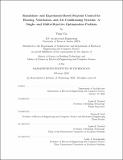| dc.contributor.advisor | Norford, Leslie K. | |
| dc.contributor.author | Cai, Yuan | |
| dc.date.accessioned | 2022-06-15T13:07:25Z | |
| dc.date.available | 2022-06-15T13:07:25Z | |
| dc.date.issued | 2022-02 | |
| dc.date.submitted | 2022-03-09T15:41:18.766Z | |
| dc.identifier.uri | https://hdl.handle.net/1721.1/143252 | |
| dc.description.abstract | Buildings and building construction sectors are together responsible for 40% of global energy consumption, 70% of electricity consumption, and 40% of carbon emission. Heating, ventilation, and air-conditioning systems (HVAC) in residential and commercial units account for 40% to 60% of energy usage. To increase energy efficiency and reduce energy usage, buildings are now better insulated, installed with energy-efficient appliances, and controlled by advanced technologies to provide user comfort while minimizing their environmental impact.
This thesis focuses on utilizing setpoint control methods to design algorithms for operating thermostatically controlled appliances such as HVAC to achieve the goal of minimizing energy consumption, cost, and greenhouse gas emission while maintaining thermal comfort and indoor air quality. The problem is formulated as a constrained convex optimization statement. Specifically, the thesis proposes three optimization-based control frameworks that are verified in simulation testbeds (with state-of-art simulation software and numerical models with MATLAB and Python). The three methods apply setpoint control on the room- and aggregate (building)- level devices and have achieved a 20% to 50% reduction in the peak load demand and greenhouse gas emission in simulation testbeds.
In addition to simulation, onsite experiments are conducted. One of the three simulation based setpoint control frameworks is implemented in two MIT classrooms. Throughout the eight experiment sessions, a significant amount of commissioning of HVAC, software, and hardware is completed. This experimental verification has demonstrated a nearly 50% savings on greenhouse gas emissions and showcased the power of data-driven control methods in real-life settings.
Although we have witnessed the successes in both simulations and experiments, the results presented in the thesis are preliminary and only serve as a proof of concept. There are still plenty of areas worth further investigation to fully materialize and implement these
methods. | |
| dc.publisher | Massachusetts Institute of Technology | |
| dc.rights | In Copyright - Educational Use Permitted | |
| dc.rights | Copyright MIT | |
| dc.rights.uri | http://rightsstatements.org/page/InC-EDU/1.0/ | |
| dc.title | Simulation- and Experiment-Based Setpoint Control for Heating, Ventilation, and Air-Conditioning Systems: A Single- and Multi-Objective Optimization Problem | |
| dc.type | Thesis | |
| dc.description.degree | S.M. | |
| dc.description.degree | S.M. | |
| dc.contributor.department | Massachusetts Institute of Technology. Department of Electrical Engineering and Computer Science | |
| dc.contributor.department | Massachusetts Institute of Technology. Department of Architecture | |
| mit.thesis.degree | Master | |
| thesis.degree.name | Master of Science in Building Technology | |
| thesis.degree.name | Master of Science in Electrical Engineering and Computer Science | |
